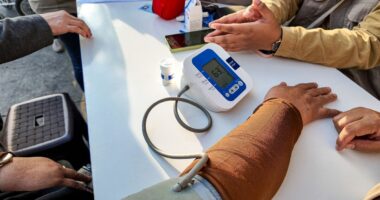Share this @internewscast.com
It was just after 7 a.m. and I was 30,000 feet in the air, somewhere above the New Mexico desert.
We were just under an hour into a five-hour flight from Los Angeles to New York City, and it was far too early to be anywhere except my bed, so I closed my eyes hoping to be back at LaGuardia soon.
Just as I felt myself falling asleep, a woman in an adjacent row stood up and shouted, ‘Someone help!’
By the time I woke, four flight attendants swarmed the row. A 51-year-old man named Sam had a seizure and was unconscious.
One of the flight attendants yelled out, ‘Is there a doctor on board?’
That’s when the whole situation started feeling less like a TV hospital drama and everything became a lot more calculated and cautious.
A doctor and at least three nurses surrounded Sam and tried to shake him awake. As he faded in and out, they asked if he knew where he was, if he remembered what happened and if he had any medical issues.
Like 100 million other Americans, Sam was prediabetic, meaning his blood sugar levels are consistently high but not elevated enough to develop into full-blown type 2 diabetes.

As a health journalist, I’ve spent years writing about medical emergencies, even those in the air. On a recent flight, I witnessed one for the first time
I wasn’t able to speak with Sam or his family, but from what I overheard, he hadn’t eaten in a while and his blood sugar had dropped dangerously low.
When this happens, the brain doesn’t receive enough energy to regulate neuron function, which can lead to seizures. The bursts of activity seizures create requires a large amount of energy, which could be why he passed out.
Dr Jason Brady, a dentist anesthesiologist and assistant program director in the Department of Dental Medicine at NYU Langone – who has assisted during in-flight emergencies – told the Daily Mail fainting makes up the ‘vast majority’ of in-flight medical incidents, along with gastrointestinal issues, shortness of breath and blood clots.
These issues are likely due to the air pressure on a plane being below sea level, which reduces oxygen levels, Dr Brady said.
Sitting on a plane without moving causes blood to collect in the legs instead of flowing back to the heart, which can lead to blood clots.
Earlier this year in a similar case to Sam’s, 35-year-old Marciela Hernandez Quezada was on a 14-hour flight from Turkey to Mexico when she suddenly suffered a stroke – the plane had to make an emergency landing. Her doctors believe sitting for most of the flight lead to a blood clot that traveled to her brain.
She is expected to make a full recovery and is in rehab.
‘Flight conditions can significantly raise the risk of adverse health events due to reduced cabin oxygen levels – affecting those with cardiac, pulmonary or neurological issues,’ Scott G Popowich, a manager at medical transport organization Tropic Air Rescue, told the Daily Mail.
Flying can also disrupt normal medication schedules.
In Sam’s case, I overheard from a family member that he left his medications in his checked bag.
‘One of the biggest mistakes is putting essential medications, like insulin or inhalers, in checked luggage instead of a carry-on. If something goes wrong, you need that stuff with you,’ Dr Raj Dasgupta, internal medicine physician and chief medical advisor for Sleepopolis, told the Daily Mail.
You’re also more likely to be dehydrated on a plane, which can also cause a ripple effect of health issues.
‘You go through security and they make you throw away your water, and then they charge you $8 for a bottle of water once you get past security. And some people just say, “Oh, I can just do without that.” And then they don’t realize how dehydrated they are,’ Dr Brady said.
‘And you’re in an environment, when you’re up in the air, that is very dry, too – it’s not like you’re in a humid place – so you get dehydrated very easy.’

Marciela Hernandez Quezada, a 35-year-old from Mexico, was on a long-haul flight from Turkey to Mexico when she suffered a stroke due to a blood clot
On this particular flight, my husband and I happened to be seated right underneath a port that flight attendants plugged a headset into so they could communicate with a health agency on the ground.
Popowich said this was likely MedAire or STAT-MD, organizations that provide medical guidance to flight crews. The pilot, meanwhile, was likely talking to air traffic control about an emergency landing.
Flight attendants asked the on-demand experts for permission to take Sam’s blood pressure, administer over-the-counter medication and even whether they could give him water.
Popowich says flight attendants have to ask for guidance every step of the way to protect against legal issues.
‘Crew must request permission for medical actions due to legal and liability protocols,’ Popowich said, adding that ‘flight attendants are limited to basic first aid without medical direction.’
Flight attendants are trained in CPR and how to use an automated external defibrillator (AED), which shocks the heart back into a normal rhythm. Planes also have emergency kits, which the Federal Aviation Administration (FAA) says includes bandages, antiseptic, pain medicine, a stethoscope and an AED.
Dr Dasgupta said, ‘Movies make it seem like everyone just jumps in and saves the day, but in real life, there’s a very specific protocol that keeps things controlled.’
There is no federal mandate for healthcare workers to respond to an in-flight emergency in the US.
However, Dr Dasgupta said ‘it’s not that common’ for a plane to have no trained medical personnel on board, and most are willing to help.

Pictured above is the list of items included in most plane emergency kits
‘Between doctors, nurses, EMTs and paramedics, there’s usually at least one person who’s able to help out,’ he said.
‘But airlines don’t count on that. They train flight attendants in CPR and emergency response and keep medical kits and defibrillators on board just in case.’
Even if you’re not a doctor, passengers can still help during an emergency.
Dr Dasgupta said, ‘staying calm, clearing space and helping grab supplies if asked can really make a difference.’
On my flight, a passenger offered up their hand sanitizer in place of alcohol wipes.
‘Filming or crowding the person isn’t helpful, it just adds stress,’ he added. ‘Don’t try to give someone water, food or medicine unless you’re told to.
‘And if you’re not medically trained, don’t try to jump in and diagnose or treat someone. The best thing most people can do is stay calm, respect the space and let the crew and any medical volunteers take the lead.’
For Sam, the team managed to get him stabilized with fluids, snacks and over-the-counter medications. He slept for the rest of the flight and had no further issues.
Dr Brady said emergency landings are generally reserved for ‘high-risk, low-tolerance situations,’ meaning not getting help right away could cost a patient their life.
Once we landed in New York, local EMTs boarded and walked Sam off the plane before the rest of us could exit.
And despite the incident, we still landed on time.














